Japan
Wood Products Prices
Dollar Exchange Rates of 10th
Oct
2021
Japan Yen 114.26
Reports From Japan
Fully vaccinated residents
expected to top 70% in
October
The government has lifted the state of emergency, the first
time since April that the entire country is not subject to
strict measure to curb the spread of the virus. The lifting
was possible as there has been a steady decline in new
infections easing of the strain on the country's medical
system.
The government plans to ease restrictions in stages to
bring back social and economic activities while also
preventing another wave of infections.
As of mid-October just over 60% of the people in Japan
have received two COVID-19 vaccine shots with 71%
having received their first shot. The proportion of fully
vaccinated residents is expected to top 70% this month.
The government plans to finish administering two vaccine
shots to all willing residents by the end of November and
it plans to begin booster shot for medical workers before
the end of this year.
Business conditions worsened in September
The Cabinet Office index of business conditions reflecting
the state of the Japanese economy marked its sharpest fall
in 15 months in September. A government official
reported in the domestic press said that the indices for
industrial output and shipments dropped mainly because of
lower output from the auto industry, the result of a chip
shortage.
The index for retail sales also trended lower as the covid
restrictions stopped people moving around.
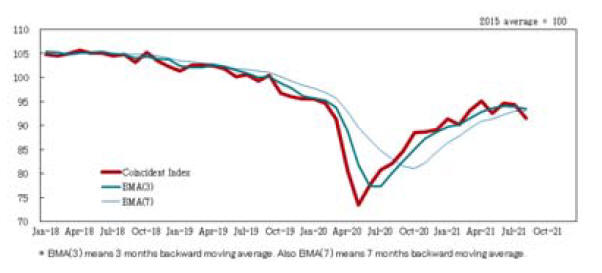
Conditions severe says Bank of Japan
Largely because of the drop in car exports the Bank of
Japan (BoJ) downgraded its economic assessments for five
of the country¡¯s nine regions.
In its quarterly Sakura report, the BoJ said the Japanese
economy remains in a ¡°severe¡± situation despite its
recovery trend. This assessment was released before the
state of emergency covering 19 of the country¡¯s 47
prefectures was lifted.
In the BoJ¡¯s Tankan survey for September the index for
current business conditions rose for the fifth straight
quarter at both large manufacturers and large nonmanufacturers.
But the survey also showed that large
manufacturers are cautious about their business conditions.
Medium and samall companies are experiencing extremely
tough conditions.
See:
www.japantimes.co.jp/news/2021/10/07/business/bojregional-downgrade/
Private sector investment stalls
Private sector machinery orders by Japanese
manufacturerse declined in August from a month earlier.
The Cabinet Office downgraded its assessment for the first
time since February, saying machinery orders, which are
considered a leading indicator of corporate capital
expenditure, showed "signs of stalling in their recovery."
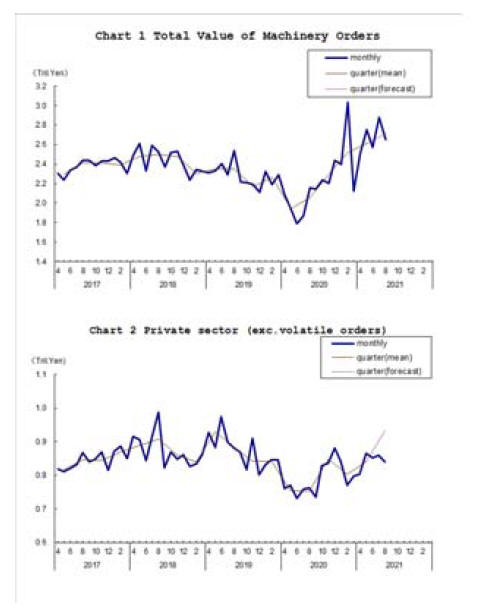
Energy costs rising, another damper on
household
spending
Household spending had been falling more sharply than
expected during the state of emergency and was
particularly impacted by curbs on holiday travel. The 3%
year-on-year decrease in spending in August was worse
than forecast and followed a 0.7% increase in July.
The latest data are a challenge for the new Prime Minister
Fumio Kishida as the country prepares for the late October
general election. Analysts expect consumption to rebound
in the coming months as the state of emergency has been
lifted and progress in the vaccination roll-out lifts people¡¯s
spirits.
Electricity prices in Japan jumped to a nine-month high in
mid-October as prices for oil, natural gas and coal are
starting to impact the cost of power generation. Japan
imports most of its energy needs so higher oil, gas and
coal prices will drive inflation higher.
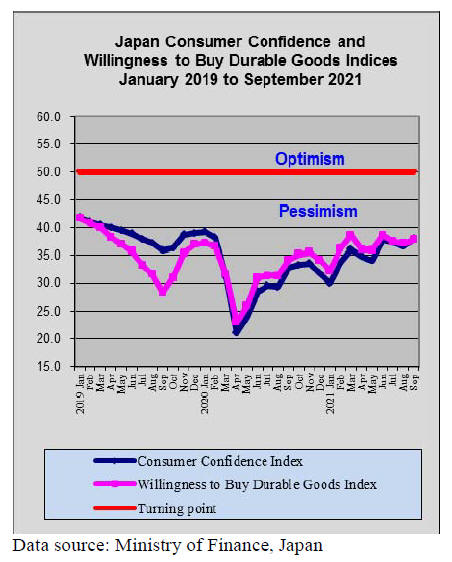
Yen at 3 year low
The yen¡¯s slipped to its lowest level in almost three years
(113.45 to the US dollar) in mid-October. This, along with
rising costs for imported energy could create a big
challenge for the government which hopes to get the
economy moving again. With Brent crude at US$85 a
barrel and rising further yen weakness is likely.
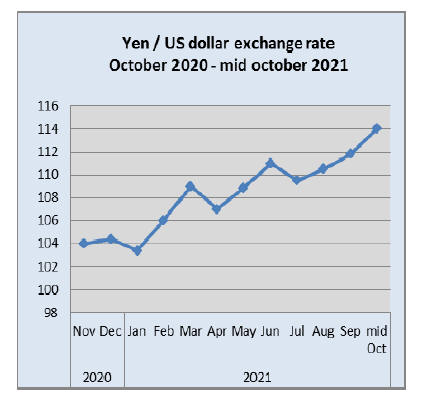
Import update
Wooden door Imports (HS441820)
Year on year, August wooden door imports (HS441820)
were 17% higher than in 2020 but still well below the
value of August 2019 imports. August marked the second
consecutive drop in the value of wooden door imports.
Compared to July, the value of August imports was almost
9% down.
China accounted for 61% of Japan¡¯s August 2021 imports
of wooden doors with a further 25% being shipped to
Japan from the Philippines. The only other significant
supplier in August was Malaysia which provided an
additional 3% of the total value of wooden door imports.

Wooden window imports (HS441810)
Data from the Ministry of Finance shows a dramatic
decline in the value of August imports of wooden
windows (HS441810). If correct August imports dropped
by almost half from a month earlier. The largest decline in
August arrivals was beacause of reduced shipments from
the US (down 90%), the Philippines (down almost 50%)
and China, the largest supplier (down 24%).
If the data is correct then the value of August
imports of
wooden windows was 15% below that in 2020 and sharply
down on the value of August 2019 imports.
Over 90% of Japan¡¯s imports of wooden windows came
from shippers in just three countries, China (54%), the
Philippines (15%) and the US (14%). Shippers in these
three countries continue to dominate Japan¡¯s imports of
wooden windows.
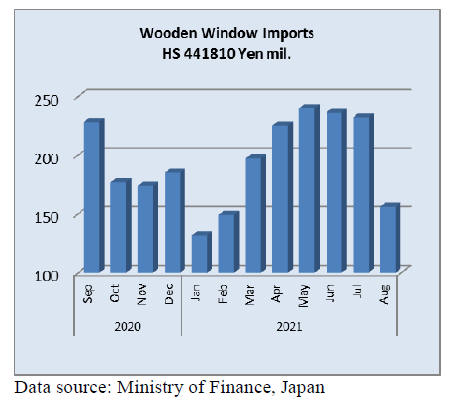
Assembled wooden flooring imports
The dip in the value of assembled flooring (HS441871-79)
in July this year no looks like a blip as imports shot up
again in August exceeding the high reported in June. Year
on year, the value of Japan¡¯s imports of assembled
wooden flooring in August this year rose 62% and they
were well up on the value of August 2019 imports.
As in pevious months imports of HS441875 was the main
category (85%) of assembled flooring imports with 42%
being shipped from China. Shippers in Vietnam continue
to do well accounting for 27% of August 2021 imports.
The other major supplier in August was Thailand.
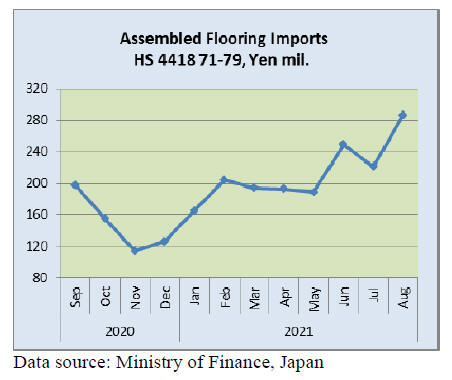
Plywood imports
Japan¡¯s plywood imports have been slipping since the
beginning of the year but the volume of August imports
was above that in August 2020 during the height of the
corona spread in Japan.
Augst 2021 imports were below that in August 2019.
Month on month, August 2021 imports were down 10%
with most of the decline being accounted for by a 25%
drop in the volume of imports from Malaysia.
Of the four main suppliers of plywood to Japan shippers in
China and Vietnam maintained their small market share in
August. Shippers in Indonesia also delivered around the
same volume in August as in July. It was shippers in
Malaysia that saw the sharp decline.
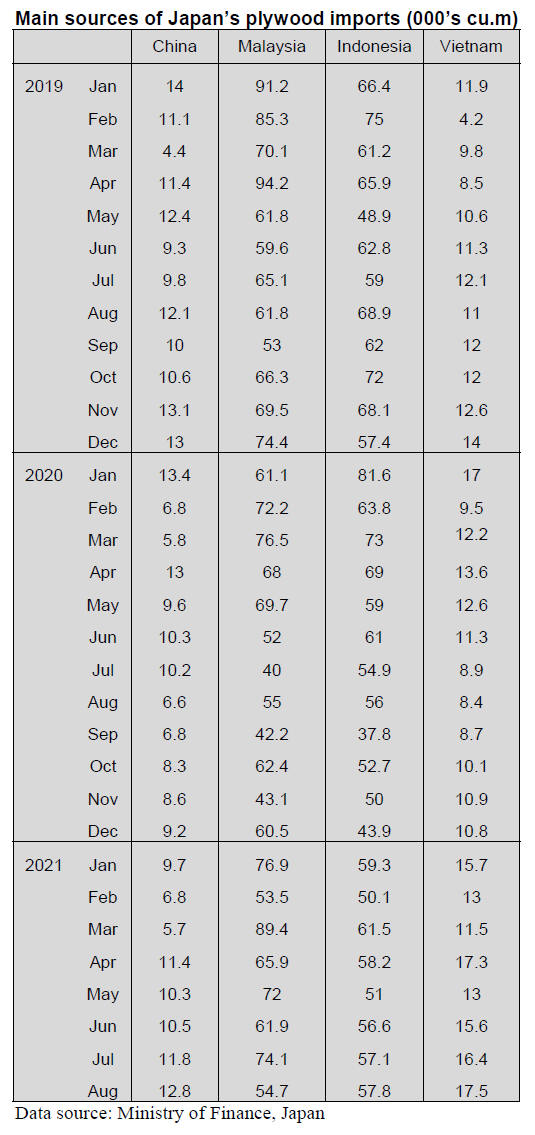
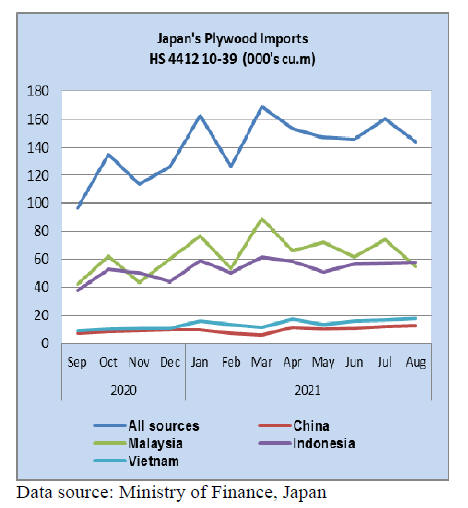
Trade news from the Japan Lumber Reports (JLR)
The Japan Lumber Reports (JLR), a subscription trade
journal published every two weeks in English, is
generously allowing the ITTO Tropical Timber Market
Report to reproduce news on the Japanese market
precisely as it appears in the JLR.
For the JLR report please see:
https://jfpj.jp/japan_lumber_reports/
Price increase of softwood plywood
Shortage of domestic softwood plywood supply is getting
critical with brisk demand by precutting plants. Plywood
manufacturers have been running full but the
manufacturers¡¯ inventory is drying up. Because of
difficulty of getting enough logs to manufacture plywood,
the manufacturers are not able to increase the production
so delayed deliveries are now common so precutting
plants are facing difficulty of smooth operations.
The manufacturers decided to increase the sales prices of
12mm 3x6 to 1,200 yen per sheet delivered since October
1. The prices of 24 mm 3x6 panel prices are now 2,400
yen and 28 mm 3x6 are 2,800 yen. Also non-structural
softwood floor base prices are 1,050 yen, 50-70 yen up
from September.
Log procurement by plywood mills is getting more
difficult. In Western Japan, purchasing cedar and cypress
logs is struggle and the log prices stay up high and some
mills are using more imported Douglas fir logs, which
prices are high. In Eastern Japan, plywood mills face hard
competition with local sawmills and laminated lumber
mills to buy cedar and larch logs at open market. Cost of
manufacturing floor base is climbing as prices of cypress
and Hokkaido fir logs to use face and back of floor base.
Shipment of softwood plywood was more than the
production in August and inventory of structural softwood
plywood inventory was 73,100 cbms, 600 cbms less than
July end.
Delay of delivery of one to two month is becoming
normal now. Wholesalers and DIY stores also keep
chasing softwood plywood with high prices.
The market prices of 12 mm 3x6 are 1,130-1,150 yen.
With short supply, the price hike this time seems to be
accepted inn no time.
Floor manufacturers showed negative attitude to higher
prices at the beginning but imported falcate floor base
prices are up because of higher log cost then delay of
delivery by shortage of containers is critical and supply of
other plywood and floor base is also difficult so to keep
stable supply of floor, they are accepting higher domestic
softwood plywood prices.
National forest timber sales increased
By sudden demand increase of domestic wood as a result
of wood shock, the National Forest moved up timber sale
plans and the sale for April through July this year is 40%
more than the same period of 2019.
Log supply from the national forest takes about 15% of
total log demand and it is functioning as adjustment
factor. In 2020, log demand decreased by COVID 19
pandemic so the national forest sales dropped by about
30%.
System sales to particular purchasers, which takes about
70% of log sales had been around 1,800,000 cbms but in
2020, it declined to 1,640,000 cbms because there was not
enough purchasers.
In 2021, things turned around and demand for logs
sharply increased. Actually it is difficult to produce logs
in short time so the National Forest moved up timber sale
plan in each district stations.
Front loading of timber sales do not promise immediate
increase of log production but compared to private timber
harvest, National forest harvest is much quicker than
private timber harvest as it has clear and definite
management plan by the forestry agency. Actually log
supply last summer did not disrupt because increase of
national forest timber sales.
Domestic log market
In Kanto region, despite active housing starts, movement
of domestic logs is slowing since late August and
downward pressure of prices is getting stronger in
September. Green lumber and 120 mm lumber have been
weakening then 105mm square, which was firm. Is
getting softer. Only firm item is cypress sill. Dealers say
that the market should firm up in October with fall
demand.
Weakness started showing since late August and mood
changed in September and steady movement of KD 105
mm post and cypress sill is holding the market.
Bearish mood is forming by factors like sharp drop
of
North American lumber market, recovery of supply of
imported wood products and entry of new products like
poplar LVL stud.
Meantime, sawmills continue bullish and if the prices
drop, they refuse to deliver lumber to dealers but the
volume of high price lumber is declining and the dealers
need to find settling level.
Only firm item of KD 105 mm square cypress sill prices
are holding 140-150,000 yen per cbm with spot high price
of 160,000 yen. Meantime, prices of KD 105 mm cedar
square, which led the market, are getting hard to hold
130,000 yen and the maximum now is 120,000 yen. KD
cedar stud (30, 45 x 105 mm), which was front runner of
high prices, turned from firm to soft with 120,000 yen but
there are less than this prices in the market now. Cedar
post and stud pries are also softening with 120,000 yen on
105 mm lumber and 100,000 yen on 120 mm lumber.
Green lumber needs to move fast as seasonally quality
deterioration is concern so the prices are weakening.
Green cedar purlin 4 meter 90 mm square prices were
55,000 yen until September but now 52,000 yen or lower.
Survey of small contractors - (impact) of wood shock
The National Federation of Construction Worker¡¯s Unions
made survey through 270 small member contactors about
wood building materials supply because supply shortage
and higher cost put pressure on small builders. These
contractors average number of building house is only 1.7
units a year. This is the second survey after last May
survey.
About half replied that supply of building materials got
worse and the prices soared. Impact to orders is that 60%
says unchanged but 40% is struggling, which fail to
conclude the contract because of higher cost. 20% stopped
taking orders because of materials shortage. Potential
house buyers are waiting to see how long the wood shock
would last.
As to building materials supply, 51% says getting worse
since last May and 42% says unchanged. For the prices,
56% says considerable increase and 37% says small
increase. For degree of price increase compared to last
May, 41% says 10-20%, 34% 30-40% and 15% more than
50%. 5% says more than double.
For precutting cost, 29% says flat, 23% says increase of
less than 10,000 yen, 23% 10,000-20,000 yen up, 12%
20,000-30,000 yen up. 13% more than 30,000 yen up.
13% absorbs higher cost by themselves, 48% bears a part
of increase and 39% passes onto the buyers.
For outlook of wood materials procurement, 79% says
uncertain or unknown. 15% says gradual improvement and
4% says back to normal by the end of the year.
For financing, 51% says no problem, 35% says it depends
on how long this situation would last and 8% says already
has problem and 5% is having public financing. 85% says
OK until the end of the year and 15% says OK until March
next year.
Plywood
Supply tightness of domestic softwood plywood is getting
grave despite full operations of plywood mills. Demand
for both structural and non-structural continues brisk and
the manufacturers¡¯ inventory is absolute minimum.
Precutting plants¡¯ operation is now depends on how soon
plywood is delivered. Wholesalers are also frantic to
secure the volume to deal with orders from local
contractors for renovation.
Shortage would last as long as direct demand such has
precutting plants continues brisk and log shortage and
high log prices would last as long as lumber market stays
bullish so the domestic manufacturers plan to keep price
hike after October.
Higher prices and supply shrinkage continue on imported
South Sea hardwood plywood. Malaysia and Indonesia are
in rainy season now and log supply continues dropping
and plywood mills face higher container freight so C&F
prices have to go higher. Japanese buyers say that further
increase of the prices are not acceptable since future
demand is uncertain but the supplying mills do not mind
losing orders if Japan does not accept the proposed prices.
Vietnamese crating panel
Shipments of Chinese and Vietnamese panels for crating
have been delayed because of COVID 19 problem in
producing regions and confused ocean transportation. Also
the cost is being pushed up by high raw materials,
adhesives and container freight.
Market prices in Japan have been climbing since last
summer on poplar LVL and plywood. Prices of Chinese
poplar LVL are affected by busy demand for housing and
higher cost of veneer. Adhesive prices have been climbing
since last summer.
Confusion of shipping is the main problem of delayed
arrivals. Manu ships are idling and tied up at ports around
Shanghai, where labor shortage caused by COVID 19
causes slower cargo handling and transshipment so
deliveries for Japan is becoming chronic now. It takes
more than three months to arrive Japan after the cargoes
ship out manufacturing plants.
Higher cost and delayed deliveries push the market prices
up in Japan. Now 50,000 yen per cbm delivered is
common and there are offers of more than 55,000 yen.
Compared to average prices of 2019, they are 30-40%
higher now.
Vietnamese plywood production is hampered by
lockdown. The plants are ready for production but not in
operation because of raw materials supply, transportation
and movement of workers. The prices are more than 20%
higher than average prices in 2020 and it is forecasted that
the prices would further advance by another 20% toward
December.
Particularly container freight is the largest concern.
Freight on direct service from Vietnam to Japan is 20
times higher than late 2020 rate. Even with this rate, it is
hard to find enough containers. In Japan, market prices of
Vietnamese plywood B are 850-900 yen per sheet
delivered, about 60 yen higher than last spring prices.
|